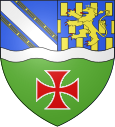Barges (Haute-Saône)
| Barges | ||
|---|---|---|

|
|
|
| region | Bourgogne-Franche-Comté | |
| Department | Haute-Saône | |
| Arrondissement | Vesoul | |
| Canton | Jussey | |
| Community association | Hauts du Val de Saône | |
| Coordinates | 47 ° 52 ' N , 5 ° 51' E | |
| height | 217-290 m | |
| surface | 7.91 km 2 | |
| Residents | 94 (January 1, 2017) | |
| Population density | 12 inhabitants / km 2 | |
| Post Code | 70500 | |
| INSEE code | 70049 | |
 Saint-Vallier church |
||
Barges is a commune in the French department of Haute-Saône in the region Bourgogne Franche-Comté .
geography
Barges is located at an altitude of 225 m above sea level, six kilometers northwest of Jussey and about 35 kilometers northwest of the city of Vesoul (as the crow flies). The village extends in the extreme northwest of the department, on the northern edge of the Mance valley , west of the height of the Donnet .
The area of the 7.91 km² municipal area comprises a section of the undulating landscape west of the upper Saône valley . The southern border mostly runs along the Mance, which flows here with several turns through an alluvial lowland around two kilometers wide . The floodplain lies at an average of 220 m and is mainly used for agriculture. From the course of the river, the municipal area extends northward over the floodplain to the adjacent, slightly undulating landscape in the area of the Rambermont and the Bois Juré , where the highest elevation of Barges is reached at 290 m. Large parts of this area are covered by forests. The western boundary runs in the lowland of the Molerupt . From a geological and tectonic point of view, the terrain consists of alternating layers of sandy-marl and calcareous sediments, which were mainly deposited during the Lias ( Lower Jurassic ). In some places shell limestone from the Triassic comes to light.
Neighboring communities of Barges are Blondefontaine in the northeast, Cemboing and Rosières-sur-Mance in the south, Voisey in the west and Melay in the northwest.
history
Barges probably originated from a grangie from Faverney Monastery , which passed to the Knights Templar before 1182 . The ownership changed later on the Order of St. John of Malta . Barges belonged to the Champagne region until 1790. With the opening of the railway line from Vesoul to Langres, the place was connected to the French railway network in 1858.
Attractions
The Gothic church of Saint-Vallier was built in the 16th century and later restored and modified several times. The Maison Commune dates from 1837 and housed the municipal administration and a school until 1971. The five village wells were built in the middle of the 19th century.
population
| Population development | ||||||||
|---|---|---|---|---|---|---|---|---|
| year | 1962 | 1968 | 1975 | 1982 | 1990 | 1999 | 2006 | |
| Residents | 148 | 114 | 107 | 106 | 81 | 91 | 108 | |
With 110 inhabitants (2007), Barges is one of the small communities in the Haute-Saône department. After the population had decreased significantly in the first half of the 20th century (388 people were still counted in 1881), slight population growth has been recorded since the beginning of the 1990s.
Economy and Infrastructure
Until well into the 20th century, Barges was primarily a village characterized by agriculture (arable farming, fruit growing and cattle breeding) and forestry. Today there are some local small businesses, including a nursery. In the last few decades the village has transformed into a residential community. Many workers are therefore commuters who work in the larger towns in the area.
The place is off the major thoroughfares on a department road that leads from Blondefontaine to Vitrey-sur-Mance . There are further road connections with Melay and Cemboing. The station has now been closed.
